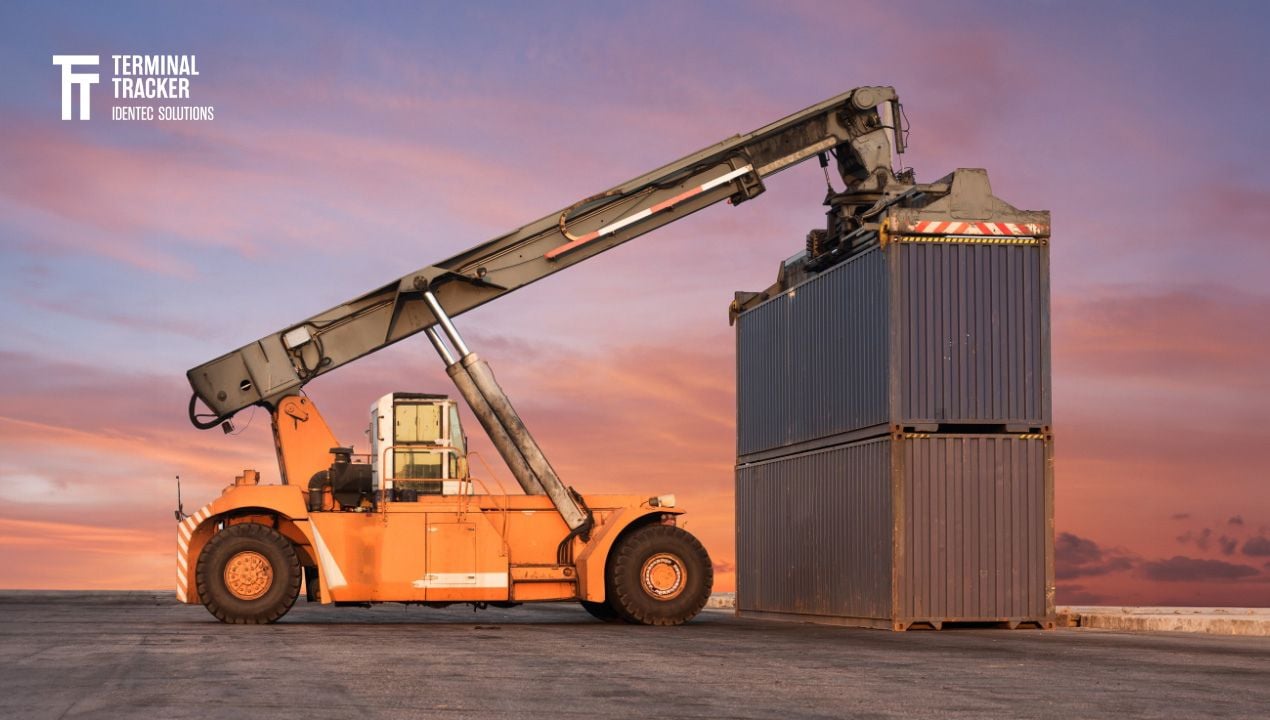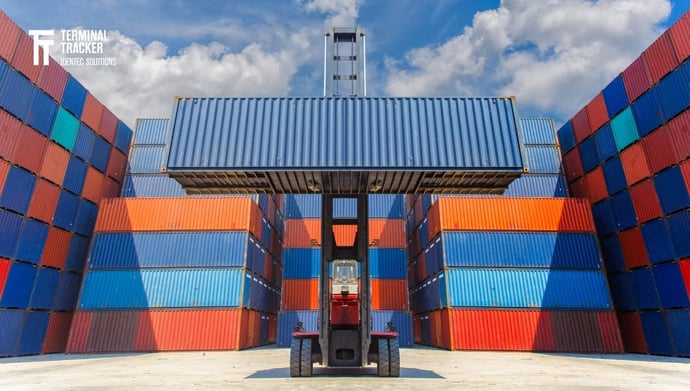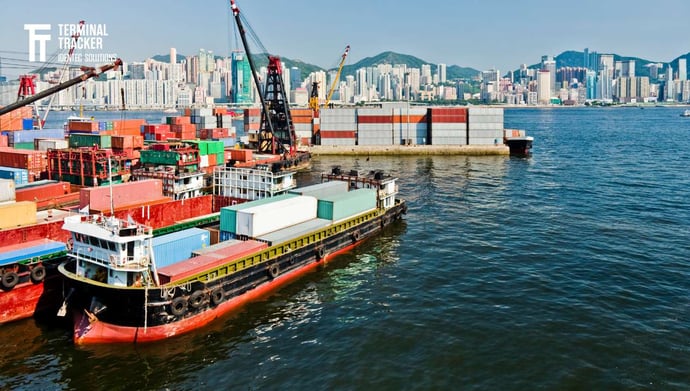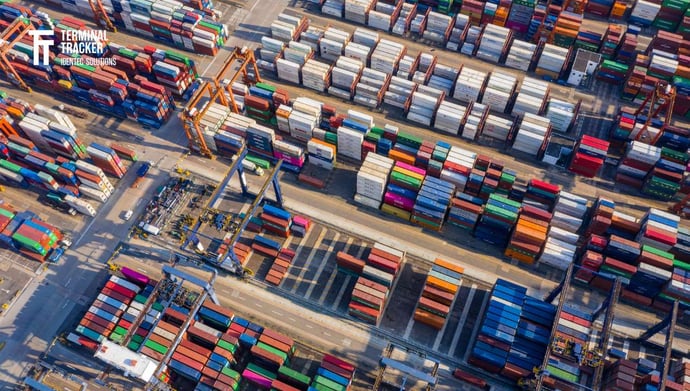CHE Operator in Container Terminal Operations
| Written by Mark Buzinkay

No video selected
Select a video type in the sidebar.
Who are CHE Operators?
There are hundreds of thousands of stevedores working worldwide. In 2022, more than 62,000 workers in the US moved containers at container terminals. The fleet of CHEs at the approximately 940 container ports worldwide is estimated to be between 100,000 and 120,000 devices. (1) A CHE operator's job is to load and unload cargo containers from ships. It takes precision and skill because cranes and straddle carriers are involved. The operatives must be adept at handling these big machines, lifting containers off ships and placing them on docks. They need technical expertise and an acute awareness of safety protocols (see also Terminal Tracker module Operator Safety). They need technical expertise and an acute awareness of safety protocols.
Beyond the docks, these operatives are responsible for transporting containers within the terminal. They use various vehicles, such as reach stackers and forklifts, to move containers from the ship to storage areas or onto trucks and trains for onward transportation. This part of the job requires a strong understanding of the layout of the terminal and efficient route planning to ensure that containers reach their designated spots without delay.
Jake is a quay crane operator, shuttle carrier and terminal tractors driver: "I basically move the containers from within the stacks up to an inspection area, border control, or I can bring them to be loaded onto rail or generally just move them around within the terminal. They might have to go to the quayside or go back and forth. Those jobs get delegated to me through control, call us up on the radio, or I've got a screen inside here which gets jobs sent out to me (see also Terminal Tracker module Job Promote). I then accept the job and then move the containers to where they need to go. The training is quite extensive; I've had weeks of training for the terminal tractors and some more for the shuttle carriers. The quay crane obviously needs the most training, which can take up to a couple of months."
Another critical aspect of their work is the storage and stacking of containers. Container terminal operatives must strategically stack containers in the storage yard, optimizing space while ensuring each container is accessible and safely placed. This task calls for an intricate understanding of the weight and size of different containers and the best methods to stack them securely.
Nicky, a quay crane operator, recounts her role: "It's a job that involves moving containers from ships to the shore, or from the shore to the ships. It's a challenge every day. It involves a lot of hand-eye coordination and precision driving, but it's a job I've always wanted to do. So basically, to pick up a container, you have to go backwards, hoist down using the levers, and collect the container. You know that you have collected it by the lights on the spreader. You need to get into four small pockets on top of the container with the four small pins that are on top of the spreader. You pick up the container, then take it to the lashing platform and then you can safely load it onto the ship" (check out the Operator Access and Operator Login Terminal Tracker modules).
A lesser-known but equally important responsibility of container terminal operatives is checking and documentation. They play a crucial role in ensuring the integrity of cargo by checking the condition of containers and verifying that the cargo matches the shipping manifests. Any discrepancies must be documented and reported, making attention to detail a crucial skill for these workers.
Effective coordination and communication are vital in a container terminal. Operatives must work closely with the ship's crew, truck drivers, and other terminal staff to ensure smooth operations. This requires not only good communication skills but also the ability to work as part of a team and solve problems efficiently.
Equipment maintenance is another key responsibility (read more about Tyre Management). Regular safety checks and essential maintenance work on the cranes, forklifts, and other machinery are essential to prevent breakdowns and ensure the safety of operations.
Speaking of safety is a paramount concern in the container terminal environment. The nature of the job, involving heavy machinery and large cargo, presents significant risks. Adhering to safety protocols and wearing the appropriate gear is non-negotiable for terminal operatives. They must constantly be vigilant to avoid accidents and ensure a safe working environment for themselves and their colleagues.

Which skills are necessary to be a CHE Operator?
The role of a container terminal operative demands a unique set of skills, encompassing both physical attributes and technical prowess, along with cognitive and interpersonal abilities.
Jane, another terminal operative, also operates cranes. "Her" crane is a rail-mounted gantry crane:" They're used for tanking the containers and putting it onto the rail and taking it off the rail and putting it onto the trailers to be moved around the port. Before, I was used to working in an office, but now, it's different because every day is a challenge, every day is different. The most challenging thing for me was changing to shift work. But it also has its benefits. I also work on shuttle carriers. These machines are used to collect the containers from behind the quay cranes from the vessels." The physical demands of the job are significant. Operatives are often required to engage in lifting, moving, and operating heavy equipment. This requires not only strength but also stamina and endurance. The ability to maintain a high level of physical activity over extended periods is crucial, especially when working in shifts that can span several hours. Physical fitness also plays a key role in ensuring the safety of the operatives and their colleagues, as fatigue can lead to accidents in such a high-risk environment.
Elisa, a reach stacker operator, has worked for years at a container terminal: "I operate a reach stacker and also a terminal tractor. With the tractor, I grab containers from the railway to the automatic cranes, and on the reach stacker, I load trailers with containers. My favourite bit of the job is operating the machinery." For her, precision is key in handling and recording cargo. In general, operatives must ensure that the cargo is handled accurately by the manifests and shipping instructions. You need to pay close attention to details so you don't end up with costly mistakes like misplacement or damage. The meticulous tracking and inventory management of cargo details is also essential in logistics. It's a highly collaborative job, so operatives have to work with other professionals like ship crews, truck drivers, and terminal staff.
Dave, a lead lasher, is also a trainer: "My job is one of the more physical jobs in the port. Basically, the first thing that we have to do is that we need to find the boxes which are being discharged at this port, and then we have to attach the lashing bars, which are a little bit heavy, and we make sure that the container is ready for the crane to discharge that box. We also set it up ready for the other boxes to come back on." Given the outdoors of the job and the variability of shipping schedules, flexibility is a key attribute for a container terminal operative. They must be able to work effectively in a variety of weather conditions, from intense heat to rain and cold. Adapting to changing schedules, including irregular hours and shift work, is also part of the job. This adaptability not only helps maintain personal effectiveness but also ensures that the operative can respond to the dynamic needs of the terminal operations.
For Dave, the dynamic nature of terminal operations means that operatives frequently encounter unforeseen challenges. These could range from equipment malfunctions to logistical issues such as delays or errors in cargo documentation. The key is the ability to think on one's feet, assess situations quickly, and come up with effective solutions. This skill is used to minimize downtime and maintain the flow of operations. Dave went to other ports to be trained as a lead lasher, but also how to be a trainer to teach others using other tools that come in handy at a container terminal.
FAQ
What soft skills does a CHE operator need?
Soft skills are critical in the modern workplace; improving communication, collaboration and problem-solving skills are essential for effective teamwork in complex environments. They enable individuals to manage the dynamics of interpersonal interactions, manage stress and adapt to changing circumstances.
For CHE operators, technical knowledge is essential, but in this stressful and harsh environment, soft skills are just as important to ensure smooth, efficient and safe operations.
- Attention to Detail: Precision is a prerequisite when handling equipment and positioning containers to avoid accidents and ensure that goods are handled correctly. Even minor errors can lead to significant disruptions.
- Communication Skills: Operators must be able to communicate information clearly and precisely, whether reporting equipment malfunctions, providing updates on container status or receiving instructions. Good coordination with team members, supervisors and other stakeholders helps to avoid misunderstandings and ensures that operations run smoothly.
- Teamwork: At the port, you work in coordination with a wide range of people, including dock workers, logistics coordinators, and drivers. Collaboration skills are, therefore, a prerequisite for carrying out tasks efficiently and safely, especially in a busy and potentially dangerous environment such as terminals.
- Problem-Solving: This skill must be present in order to be able to deal with unexpected problems. Broken equipment, unforeseen delays, or operational challenges: operators must be able to think quickly and find effective solutions.
- Time Management: Operators must manage their time efficiently to meet deadlines and ensure that tasks are completed promptly. Effective time management helps to maintain operations and avoid bottlenecks.
- Stress Management: The global supply chain is under a lot of pressure. Operators are faced with tight deadlines, unexpected delays or difficult weather conditions. The ability to remain calm and focused under pressure is critical to maintaining safety and efficiency.
- Adaptability: Logistics is dynamic, with frequent changes in operations, technology,, and conditions. To remain effective and efficient, operators must be flexible and open to learning new methods and adapting to changing circumstances.
Takeaway
An interesting aspect of their role is the global impact of their work. CHE operators handle goods that are shipped worldwide, making them key players in the international trade network. The increasing integration of technology and automation in terminal operations, such as the use of automated guided vehicles and advanced crane operation systems, is also transforming the way terminals operate, adding an exciting technological dimension to their work. In summary, the role of a container terminal operative is multifaceted and vital. From the precise operation of heavy machinery to the strategic stacking of containers and meticulous documentation, their work ensures the smooth and efficient flow of goods across the globe. Their contribution, though often behind the scenes, is essential in keeping the wheels of global trade turning.
Dive deeper into one of our core topics: Smart Port
Glossary
A lashing bar is a steel tool used in maritime shipping to secure cargo containers on ships. It connects containers to the vessel's structure or other containers, preventing movement during transit. Lashing bars work in conjunction with turnbuckles and other securing equipment to form a robust cargo-securing system. They are essential for maintaining cargo stability, enhancing vessel safety, and complying with international maritime regulations. Lashing bars come in various designs, including vertical, external, and swivel-head types, to accommodate different securing needs. (2)
A stevedore is a skilled worker responsible for loading, unloading, and managing cargo at ports and terminals. They operate heavy machinery like cranes and forklifts to handle various types of cargo, including containers, bulk goods, and project cargo. Stevedores ensure efficient and safe cargo operations, proper stowage, and secure fastening of goods for transport. Their role is crucial in maintaining the smooth flow of maritime trade and intermodal transportation, acting as the vital link between sea and land transport. (3)
Sources:
(1) https://www.apmterminals.com/en/about/white-paper
(2) Cargo Work for Maritime Operations by D.J. House, Routledge, 2016
(3) Port Operations, Planning and Logistics by Khalid Bichou, Informa Law from Routledge, 2020
Note: This article was updated on the 7th of February 2025

Author
Mark Buzinkay, Head of Marketing
Mark Buzinkay holds a PhD in Virtual Anthropology, a Master in Business Administration (Telecommunications Mgmt), a Master of Science in Information Management and a Master of Arts in History, Sociology and Philosophy. Mark spent most of his professional career developing and creating business ideas - from a marketing, organisational and process point of view. He is fascinated by the digital transformation of industries, especially manufacturing and logistics. Mark writes mainly about Industry 4.0, maritime logistics, process and change management, innovations onshore and offshore, and the digital transformation in general.




